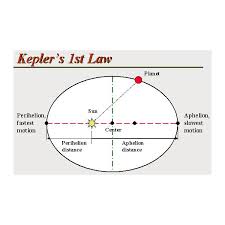Johannes Kepler, a 29-year-old German, became one of Brahe’s assistants when he moved to Prague. Brahe trained his assistants to use instruments, such as those shown in Figure 7-1. Upon his death in 1601, Kepler inherited 30 years’ worth of Brahe’s observations. He studied Brahe’s data and was convinced that geometry and mathematics could be used to explain the number, distance, and motion of the planets. Kepler believed that the Sun exerted a force on the planets and placed the Sun at the center of the system. After several years of careful analysis of Brahe’s data on Mars, Kepler discovered the laws that describe the motion of every planet and satellite. Kepler’s first law states that the paths of the planets are ellipses, with the Sun at one focus. An ellipse has two foci, as shown in the Figure . Like planets and stars, comets also orbit the Sun in elliptical orbits. Comets are divided into two groups—long-period comets and short-period comets— based on orbital periods, each of which is the time it takes the comet to complete one revolution. Long-period comets have orbital periods longer than 200 years, and short-period comets have orbital periods shorter than 200 years. Comet Hale-Bopp, with a period of 2400 years, is an example of a long-period comet. Comet Halley, with a period of 76 years, is an example of a short-period comet. Kepler found that the planets move faster when they are closer to the Sun and slower when they are farther away from the Sun. Thus, Kepler’s second law states that an imaginary line from the Sun to a planet sweeps out equal areas in equal time intervals, as illustrated in the Figure Kepler also found that there is a mathematical relationship between periods of planets and their mean distances away from the Sun. Kepler’s third law states that the square of the ratio of the periods of any two planets revolving about the Sun is equal to the cube of the ratio of their average distances from the Sun. Thus, if the periods of the planets are TA and TB, and their average distances from the Sun are rA and rB, Kepler’s third law can be expressed as follows Kepler’s Third Law The squared quantity of the period of object A divided by the period of object B, is equal to the cubed quantity of object A’s average distance from the Sun,
divided by object B’s average distance from the Sun.

